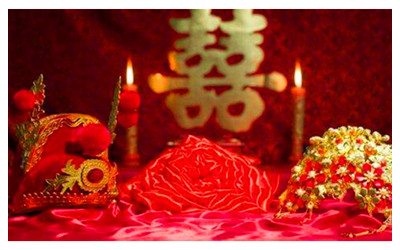
Chinese Traditional Marriage
 During the Warring States period (402-221 BC), Chinese marriage became custom. Due to the vast expanse and long history of Chinese marriage customs and ceremonies, there are different practices that are followed in different places, although they all generally adhere to similar guidelines. Visitors still have opportunities to witness traditional marriages in the countryside. Nowadays, it is also very important in China for a couple to follow a basic principle of the "Three Letters and Six Etiquettes" since they were essential to a marriage.
During the Warring States period (402-221 BC), Chinese marriage became custom. Due to the vast expanse and long history of Chinese marriage customs and ceremonies, there are different practices that are followed in different places, although they all generally adhere to similar guidelines. Visitors still have opportunities to witness traditional marriages in the countryside. Nowadays, it is also very important in China for a couple to follow a basic principle of the "Three Letters and Six Etiquettes" since they were essential to a marriage.
Three Letters
The "Three Letters" included the Betrothal Letter, Gift Letter and Wedding Letter. The Betrothal Letter was the formal document of the engagement, a must in a marriage. Next was the Gift Letter, which would be given to the identified girl's family. Within the letter would be a list of the types and quantity of gifts designated for the wedding, once both parties accepted the marriage. The Wedding Letter was prepared and presented to the bride's family on the day of the wedding and was a document that confirmed and commemorated the formal acceptance of the bride into the bridegroom's family.
Six Etiquettes
Proposing: If an unmarried boy's parents identified a girl as their future daughter-in-law, they would then locate a matchmaker. Proposals were the specialties of the matchmakers. The matchmaker would formally present his or her client's request to the identified girl's parents.
1. Birthday matching
If the potential bride's parents did not object to the marriage, the matchmaker would then ask for the girl's birthday and birth-hour to assure the compatibility of the potential bride and bridegroom. If the couple's birthdays and birth-hours did not conflict according to astrology, the marriage would continue onto the next stage. If there was any sign of astrological conflict, which meant the marriage would bring disasters upon both families, the proposed marriage was immediately quashed.
2. Presenting betrothal gifts
Once both birthdays matched, the bridegroom's family would then arrange for the matchmaker to present betrothal gifts, including the betrothal letter, to the bride's family.
3. Presenting wedding gifts
After the betrothal letter and betrothal gifts were accepted, the bridegroom's family would later formally send wedding gifts to the bride's family. Usually, gifts may include tea, lotus seeds, longan, red beans, green beans, red dates, nutmeg, oranges, pomegranate, lily, bridal cakes, coconuts, wine, red hair braid, money box and other delicacies, depending on local customs and family wealth.
4. Picking a wedding date
An astrologist or astrology book would be consulted to select an auspicious date to hold the wedding ceremony.
5. Wedding ceremony
On the selected day, the bridegroom departs with a troop of escorts and musicians, playing cheerful music all the way to the bride's home. After the bride is escorted to the bridegroom's home, the wedding ceremony begins...More
6. Bride's Return
Traditionally, the newlyweds are to return to visit the bride's parents one or three days after the wedding. They will be hailed with a banquet and it is the bridegroom's turn to suffer the well-intentioned teasing of the bride's relatives and friends.
Traditional marriage customs lost their popularity due to the collapse of feudal marriage customs and their complexity. However, traditional marriage can still be seen in the countryside, despite innovations. Now, traditional marriage customs are being revived in some places and they are attracting many prospective couples.







 Ask Questions ?
Ask Questions ?